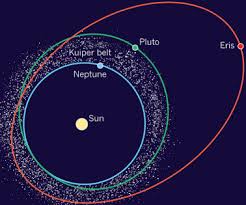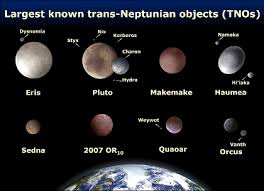Overview
Parts of the Solar System are beyond the great distances of the Kuiper Belt. These bodies may have a close approach to the Sun within 30 to 50 AU, but their orbits are so eccentric and elliptical that their furthest point is over 100 times the distance between the Earth and the Sun. These regions include the scattered disc and the Oort region. Some dwarf planets and planetoids, such as Eris and Sedna, are located here. Comets are thought to form in this unstable region of space,then brought inward by the gravitational pull from the giant planets.
The Scattered Disc
The scattered disc is a highly dynamic area of space. Astronomers who were looking for objects as distant as the Kuiper Belt also found objects that were at different angles outside of the area they predicted. They theorized that those objects were in orbits that brought them closer to the gravitational pull of Neptune than those in the Kuiper Belt. However, their orbits were far more elliptical, so that their furthest point they are far beyond the outer reaches of the Kuiper Belt.
Eris, Sedna, and Beyond
The dwarf plant Eris in the largest body in the scattered disc. It is about 1 ½ times as massive as Pluto, and a year of about 558 years. At its closest point, its orbit is theorized to be inside the orbit of Pluto, at about 38 AU. At its furthest point away from the Sun, it is almost at 98 AU. Observations with the Hubble Space Telescope show a rocky structure and bright methane ice, similar to Pluto. It has one moon, now named Dysnomia. Before its official name, the planet was nicknamed by the team of astronomers who discovered it. It was nicknamed Xena with its moon Gabrielle. Another dwarf planet, Sedna, at its closest point is 76 AU from the Sun, and at its furthest point it may be 937 AU from the Sun. Sedna’s orbit is thought to take over 11,000 years.
Short-Period Comets
Comets that take less than 200 years to orbit the Sun are called short-period comets by astronomers. They are thought to form in the scattered disc, because their orbits are eccentric and influenced by the gravity of the large planets and drawn inward by the Sun. Some of those unstable bodies are closer to the Sun, between Jupiter and Neptune, and are called centaurs, because they are similar to both comets and asteroids.
The Oort Region
Long-period comets and short-period comets similar to Halley’s Comet are theorized to form in a region of space about 2 light-years away from the Sun. It is named for the astronomer who first theorized its nature. The Oort Region is a vast sphere containing icy planetesimals that are tossed further into the Solar System by gravity tides from passing stars. Those objects are captured by the outer planets, and the icy balls that remain intact are then catapulted into cometary orbits by the Sun.
Interested in science tutoring services? Learn more about how we are assisting thousands of students each academic year.
SchoolTutoring Academy is the premier educational services company for K-12 and college students. We offer tutoring programs for students in K-12, AP classes, and college. To learn more about how we help parents and students in Wake Forest, NC: visit Tutoring in Wake Forest, NC




